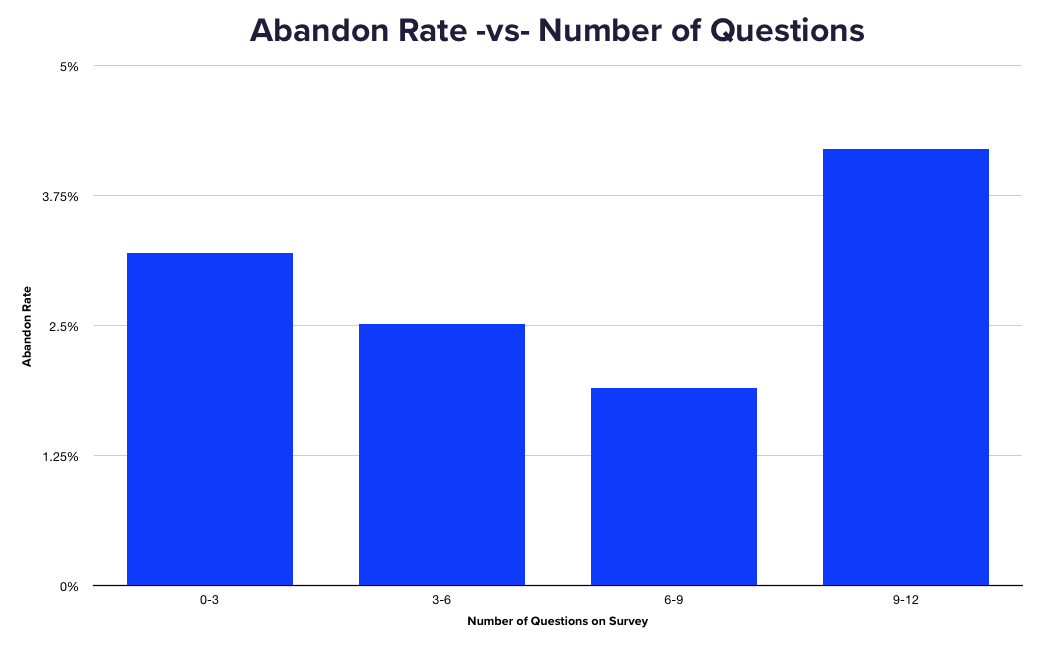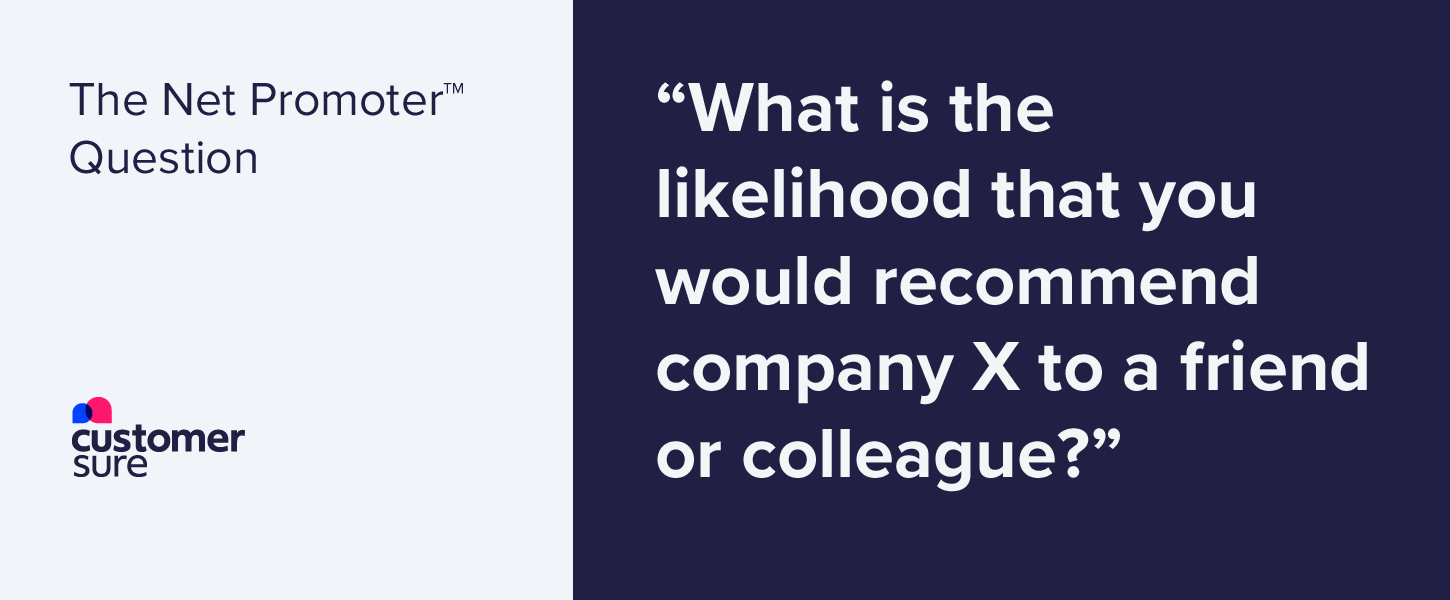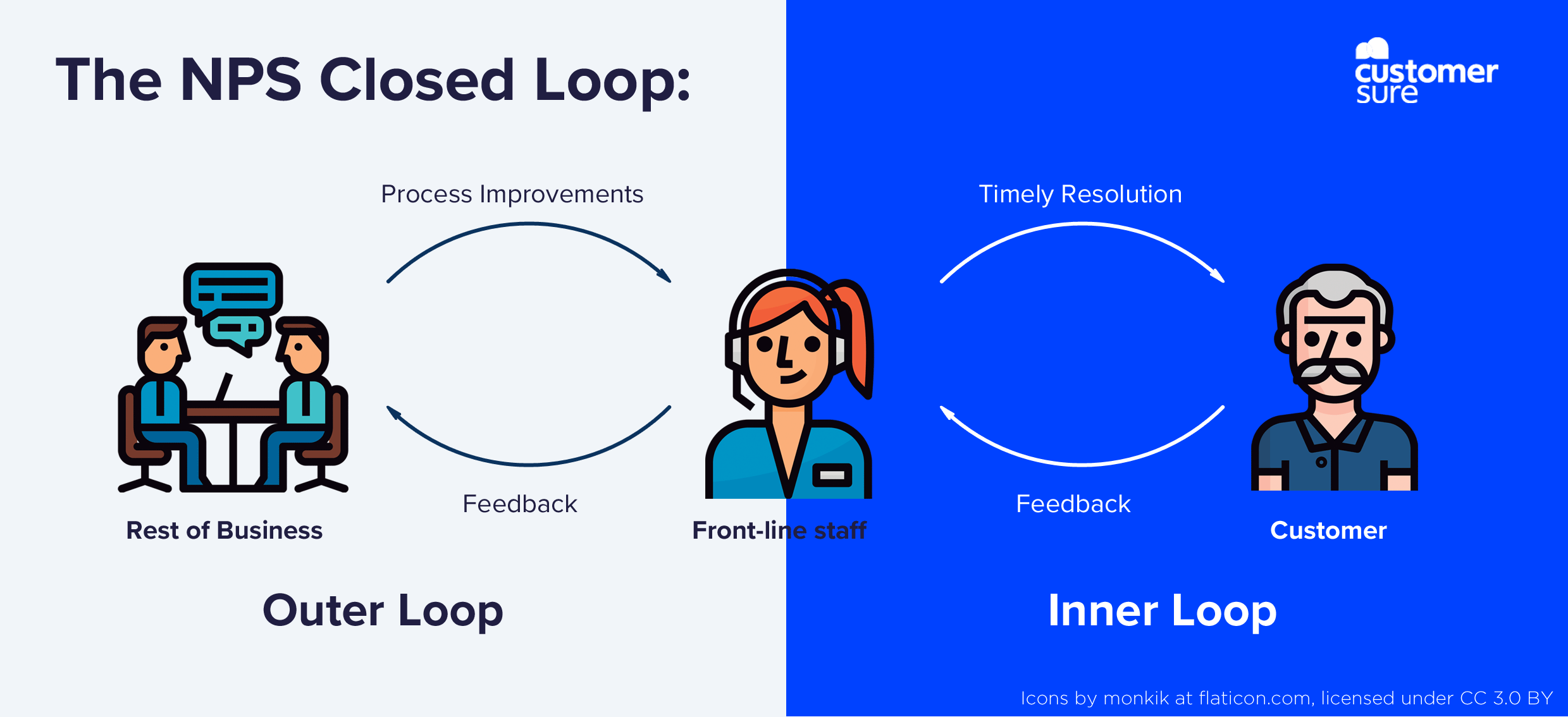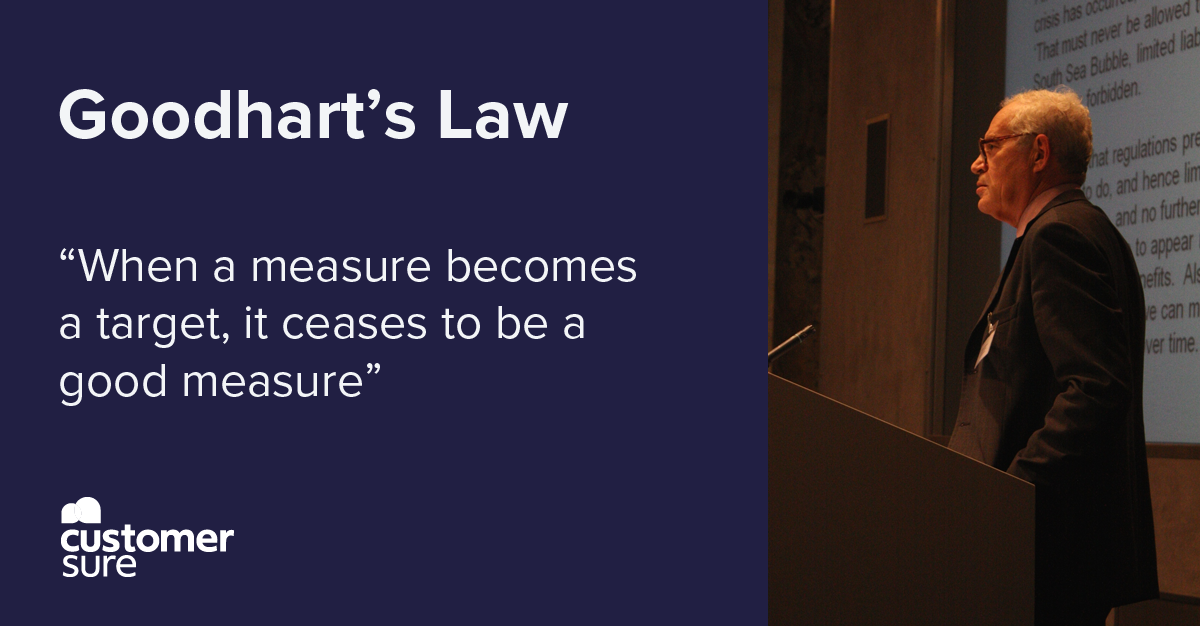How to Improve NPS (Net Promoter Score)
Now you know what NPS is, and how to calculate it, it’s time to start improving it.
We asked our customers to share actionable advice from their own Customer Experience practice, and boiled it down to this list of ten tips.
But remember, NPS is a means, not an end. It’s a score that tries to measure customer loyalty, but just measuring it is never going to generate loyal customers.
Anything which promises an increase in your NPS but does not actually make your customers’ lives better is a false economy.
Bad metrics are one of the biggest threats to CX improvement.
We’ve seen (literally) hundreds of sneaky ways of trying to improve an NPS score (because someone’s bonus depends on it) without any corresponding improvement in underlying customer retention or revenue.
Improved NPS should only ever result from genuine improvements to how customers feel about you, which should generally come from a true voice of the customer programme which turns their feedback into actions.
Here’s some practical ways you can tune-up your VOC programme to result in improved NPS:
1. Map your journeys first
CX teams are rarely empowered to make operational changes. Instead, it’s usually their role to deeply understand customer needs and demonstrate the case for making changes based on these needs to other teams.
A great way to ensure that this handover is seamless and results in genuine customer improvements, which in turn result in improved NPS, is to carry out customer journey mapping as the first stage of any CX improvement project.
Doing journey mapping well will ensure everyone in the business shares an understanding of the interactions that customers have with you, but — crucially — will ensure that people are responsible for these journeys. This stops urgent actions falling through the cracks: Instead, they end up on a named person’s desk, and that person takes action to fix them.
2. Ask more (and better) questions
You can improve NPS by asking the right questions.
No, not the sort of false improvements which can result from dodgy questions like “To reward the team member who helped you today, please score us a 9 or 10, and if you score any lower, they’ll get upset”.
You can read the details in our guide to NPS surveys, but it boils down to this:
Don’t just ask the NPS question, ask customer-centric follow-up questions on your survey. You’ll get more, and better data.
You shouldn’t ask ‘if’ somebody would recommend you, without asking ‘why?’. That’s why the traditional NPS survey consists of the NPS question and a free-text followup.
Of course it’s easy to use AI sentiment analysis to find out what customers are telling you at scale. But if customers don’t leave any comments, you have nothing to analyse. Sometimes people just don’t have strong feelings, or just don’t have the time or energy to type anything.
There’s one really bad way of addressing this: Comment boxes which force the customer to type a certain number of words before they submit the form. Who wants to do that? It’s not a great customer experience… You’ll struggle to improve NPS with terrible NPS surveys.
Better is to keep the text question optional, and ask a small number of detailed scored questions which are aligned with the customer’s interests. These questions are easy for customers to answer, meaning they get answered more often, and you get valuable insight into the drivers behind the topline retention metric.
You might worry that asking more questions reduces response rate, but we’ve crunched the numbers on this. Abandon rate only really starts to climb when you ask an overwhelming number of questions:

It’s interesting that response rate actually rises for mid-length surveys. It’s impossible to know why this is (without asking customers to complete yet another survey), but our theory is that if customers see a few scored questions that align with their priorities, they trust you’re taking NPS improvement seriously, and are more inclined to lend you their time.
3. Ask at the right time
Want to know how to ruin a first date?
Casually asking “do you love me?” is a great place to start.
But that’s exactly what many companies do with NPS.

It’s a question specifically designed to measure loyalty. So it’s a question that you should only ask when you’ve given customers a chance to become loyal.
Asking it of brand new customers is just like a “do you love me” on a first date.
In the absolute best case scenario, customers will give you a ‘polite’ answer that doesn’t reflect their true loyalty. In the worst case, customers will be annoyed at the question and score you a ‘0’.
If you want to improve NPS, make sure you’ve mapped customer journeys correctly, and you’re asking NPS at a time where it makes sense to do so.
Of course it’s a good idea to ask new customers for feedback, but don’t use NPS to measure satisfaction. Other metrics, like CSAT and CES are available.
4. Act on Feedback Quickly (The NPS Outer Loop)
The biggest lie in customer experience is that “you can’t respond to every bit of customer feedback”.
We’d turn this on it’s head:
If you want to improve NPS, and you’re not responding to every bit of feedback, you’re just trying to fill a leaky bucket. The only reason to ask people what they think is if you’re prepared to act on it. The best CX teams know this, and it’s a competitive advantage.
OK, you don’t need to respond to every single bit of feedback. It’s nice to be nice, but typing out a thank-you note to every promoter isn’t going to significantly improve NPS.
But if you’re not picking up on every meaningful comment, and engaging with the customer who left it, you’re squandering goodwill and revenue. It’s easier to retain an existing customer than to win a new one.
If your VoC process is well designed, you’ll easily be able to prioritise feedback based on raw customer scores, and AI-calculated sentiment in text comments. What’s more, you’ll be able to route feedback to the correct stakeholders to take action, so there’s no bottleneck in the business: feedback comes in, and gets sorted out.
No customer fills in a feedback form hoping to be ignored.
The world-class teams we work with tell us that closing the inner loop is probably the simplest, most effective tool they have to drive up NPS, and as a consequence, drive up profit.
5. Act on Feedback Slowly (The NPS Outer Loop)
Following up with customers is only one of the two so-called ‘loops’ in the Net Promoter System.

The other loop, the ‘outer loop’ (using customer feedback to steer your process improvements) is also important if you want NPS to actually improve.
Shockingly, you can’t just ask customers what they think, do nothing about it, and hope things will get better.
But effecting change in any organisation can be a slow process. So how do you make sure things actually improve over time?
Our customers tell us:
- Make sure people who can effect change have access to clear summaries of top priorities. A platform like CustomerSure can instantly show the owner of any touchpoint a summary of customer feedback relating to their role, and recommend the most impactful actions.
- Make sure people have access to verbatim customer comments. Nothing motivates people like seeing customers explain their problems in their own words.
6. NPS Champions
Customer experience isn’t just delivered by your front-line staff.
Customer experience is the sum total of all the interactions a customer has with your organisation.
You can drill your contact teams to within an inch of their lives, but if your accounts department are monsters, terrorising your customer base… You’ll struggle to improve NPS.
Satisfaction — and thus retention — will only consistently improve if it’s a priority for your entire organisation: from the board down. But it’s not reasonable for ‘CX improvement’ to be part of everyone’s day job.
One good solution we’ve seen is embedding ‘NPS Champions’ in non-customer-facing teams.
It’s their responsibility to own the NPS project in their area of the business, even if a CX team are managing the overall VoC platform by sending surveys, analysing the results, and routing insights to the right people.
These ‘champions’ make sure that feedback relating to their division gets dealt with. Rude payment chasers? It’s up to your Finance Champion to organise training and make sure things change. Missed appointments by your field technicians? It’s up to your Operations Champion to drive the process improvement that stops this happening.
7. Do not use incentives for NPS.
You should never, ever incentivise your staff or your customers in your feedback process. That means no Amazon vouchers for customers, and no bonuses linked to NPS targets for staff.
OK, there is a chance this could lower NPS… If you stop bribing customers to give you a ‘10’, scores could potentially drop. But as we discussed in the intro, we’re not interested in NPS improvements which result from simply inflating your scores: We work with teams to produce lasting improvements in customer satisfaction, which lead to higher scores.
Don’t Incentivise Your Staff
This is one of the many, many areas of customer feedback where you can easily fall victim to Goodhart’s Law, if you’re not careful:

It’s fine to measure how satisfied your customers are. But as soon as you make it a target, and link bonuses to that target, people will come up with ways to hit their target – whether or not it’s sensible or ethical to do so.
If you incentivise your staff on customer satisfaction, get ready for your staff inventing ‘creative’ ways to hit high NPS scores, including, but not limited to: fake feedback submissions, begging customers for high scores, ‘forgetting’ to ask unhappy customers for feedback, or even bribing customers by giving them better deals than is commercially sensible.
Don’t Incentivise Your Customers
This one’s simpler to explain.
How honest do you think customers are if they believe their chance of winning an iPad (or Amazon vouchers, or a new set of golf clubs, or a holiday in Malibu for two) rests on how much they flatter you?
Don’t offer to enter your customers into a prize draw in exchange for their feedback. Even if you’re hoping to improve response rates.
It’s perhaps OK to offer everyone a reward for completing a feedback form, but it’s not really necessary.
If you bribe people to become NPS promoters, you may receive more 9s and 10s, but you’ll receive a lot less useful data which you can use to create lasting commercial improvements in your company.
In Summary…
There’s one sure way to improve your NPS. Treat every single customer as an individual, don’t guess if you’ve done a good job for them, check, and put things right if you haven’t.
If only it were as simple to do as it is to say, there would be a lot more amazing customer service in the world.
But by keeping it as your objective, taking the customer’s side in every decision you make, and fighting their corner to others in your organisation, you can go a long way.
In his book which introduced NPS, Fred Reichheld goes to great pains to emphasise one of the main reasons to do NPS is because “it’s the right thing to do”. Behind every record in a CMS system is a real human being, with enough going on in their life that they don’t need the added burden of dealing with companies who don’t care about them. It just happens that when you do genuinely care your business becomes more profitable.
We hope these guides make it easier for you to make your team, or organisation more customer-focused, but if you need more bespoke advice, we love talking to people like you, so drop us a line and tell us what’s on your mind.
Is your VoC programme delivering measurable results?
Gain a clear view of how mature your VoC programme is, and receive tailored recommendations to take it to the next level.
Take the assessment »